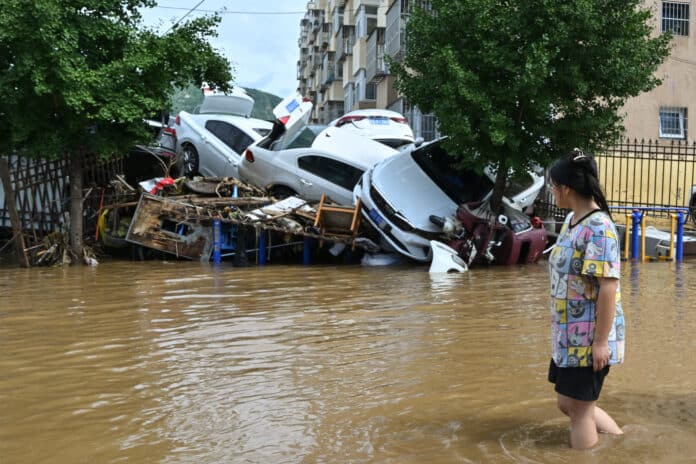Climate change and extreme weather compounded by bureaucratic cost-cutting and bungling
Li Yong and Moby, ISA China
Beijing has been hit by extreme rainfall again, even more severe than the devastating rainstorm in the Beijing-Tianjin-Hebei region two years ago and setting a new 140-year record. From 23 to 30 July, torrential rain continued unabated. Some areas received a staggering 744 millimeters of rainfall, equivalent to a year’s total rainfall in just a few days. So far, the floods have caused at least 44 deaths in Beijing and forced the evacuation of over 80,000 people.
The heaviest death toll occurred at a nursing home in Miyun District, where at least 31 people died after being trapped inside the building by the terrifying speed of the floodwaters. CCTV News reported that 48 people were rescued from the nursing home, some being pulled through windows and onto boats, but the report did not mention any deaths. It was later reported that local officials were among the missing in Miyun. The heavy casualties were attributed to the authorities’ failure to issue a timely warning before the Miyun Reservoir released its waters, issuing a website announcement only 33 minutes before the release.
Afterwards, officials of the CCP (China’s dictatorship) publicly acknowledged failings and apologized. Because the nursing home was considered to be located in a “safe” area, there was no evacuation plan. Miyun’s CCP secretary Yu Weiguo admitted, “For a long time, the town center where the nursing home is located has been safe… Our understanding of extreme weather events was insufficient.”
However, this “apology” only addresses part of the problem: As climate destruction intensifies and extreme weather events become more frequent, the authorities’ overall emergency preparedness is seriously lagging behind. An equally serious problem is posed by China’s reservoir and hydropower management system.
Reservoir at maximum capacity
To maximize power generation efficiency, China’s dams often pursue very high water storage capacities. This results in extremely limited reservoir regulation capacity during heavy rains and floods. The Miyun Reservoir’s normal water level is supposed to be 152 meters, and during flood season the level should be proactively lowered to 150 meters to mitigate flooding. However, reports indicate that the reservoir level has been consistently high at 155 meters, leaving the dam at close to maximum capacity with no room or time for maneuver. Heavy rains can instantly cause the water level to surge to dangerous levels, forcing immediate flood discharges to prevent serious damage or even collapse. This leaves downstream areas with insufficient time to respond. This is the most likely explanation for the devastation and fatalities that occurred in Miyun.
It’s rare for Chinese Communist Party officials to apologize for mistakes and shortcomings in their crisis response. This may signal a shift in the CCP’s “style” in 2025 as the regime feels increasingly isolated, exposed and subject to public criticism. Beijing’s Vice Mayor Xia Linmao also issued a statement: “There are still shortcomings in our work, including insufficient forecasting and early warning capabilities for extreme weather, inadequate disaster prevention and mitigation plans, and deficiencies in infrastructure development in mountainous areas.”
Apologies, however, don’t change anything and won’t prevent the next disaster. Action is needed and this can only come about from a complete change of system. Mass democratic supervision and control by the working class over government and the economy is needed, with the elimination of profit-worship and top-down authoritarian rule.
The deadly floods in Beijing are yet another manifestation of the global climate crisis. Last year was China’s hottest year on record and 2025 is likely to claim that title as well. China has been experiencing an extreme heatwave since March of this year. By July, 152 observation centers across the country recorded temperatures exceeding 40 degrees Celsius, with Turpan in Xinjiang recording a high of 49 degrees Celsius. Higher temperatures increase the atmosphere’s ability to hold moisture; for every 1 degree increase in the earth’s average temperature the amount of water vapor in the atmosphere can increase by 7 percent.
Once again, a natural disaster has been exacerbated by the bureaucratic, profit-driven CCP-capitalist system. This is a disaster wrought by global capitalism. On the one hand, there are carbon-addicted scoundrels like Trump, who deny the climate crisis and further promote the fossil fuel industry, accelerating the climate apocalypse. On the other hand there is the CCP, which despite paying lip service to “green” solutions pumps out 33 percent of the world’s carbon emissions, burns more than half the world’s coal, and has built more than half of the world’s mega-dams.
World’s biggest dam
For example, the CCP is currently building the world’s largest hydroelectric dam project, the Medog Hydropower Station, near the Indian border in Tibet. When completed this will be three times bigger than the Three Gorges Dam, currently the world’s biggest. These dams, while veiled in green, are driven by factors such as economic power, politics, and geopolitics. The timing of the Medog dam is probably also linked to the CCP’s internal power struggle, with pro-Xi and anti-Xi factions fighting a war for control of key state positions. Big dam projects mean big money for top CCP officials and their capitalist crony networks.
Whether these dams are actually needed is far from clear, but should be decided democratically, following a full, open and independent review process. They should be operated, planned, controlled, and managed by organisations of the working class and local communities to put safety, nature, and the people’s well-being before profit.




